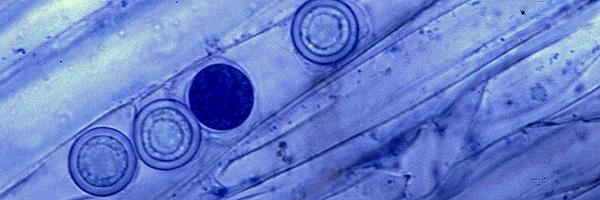
Pythium spp. / Phytophthora spp.
Damping-off, root and crown rots
- classification : Chromista, Oomycota, Oomycetes, Saprolegniomycetidae, Pythiales, Pythiaceae, Pythium sp.
Protozoa, Alveolata, Oomycetes, Peronosporomycetidae, Peronosporales, Incertae_sedis_, Phytophthora sp.
- dénomination anglaise : damping-off, root and crown rot, fruit rot, vine decline, sudden wilt ...
Oomycetes are present in the soils of many Cucurbitaceae production areas around the world; they can be rampant just about anywhere melon is grown. They are likely to cause damage throughout the production cycle of this plant, both in nurseries on seedlings and in crops on adult plants. Symptoms can be observed on all organs of Cucurbitaceae: roots, crown, leaves, stems and fruits.
In France , some species Pythium are mainly responsible for damping-off, in particular in extensive and / or poorly managed nurseries. These pathogenic chromists are also found, in complexes with other soil-borne pests, associated with root dieback. Among the Phytophthora spp. , only Phytophthora capsici punctually rages on Curcurbitaceae, especially on zucchini and squash, sporadically on melon fruits.
The species of Pythium and Phytophthora pathogenic on melons are treated in the same sheet (except Pseudoperonospora cubensis and Phytophthora capsici ) for at least three reasons: their biological characteristics and the symptoms they cause are quite comparable, their development is often influenced by the same conditions and the protection methods used to control them are identical.
* There are about 800 saprophytic or parasitic species of Oomycetes which have long been classified as Phycomycetes or “lower fungi” (Eumycetes). This classification was revised a few years ago because the ultrastructure of these microorganisms, their biochemistry and their molecular sequences indicated that they belonged to the Chromists, including mainly algae (green and brown), diatoms. Currently, depending on bibliographic sources, they can be associated either with the reign of the Chromista (Index fungorum), or with the reign of the Stramenopila (Tree of life).
In France , some species Pythium are mainly responsible for damping-off, in particular in extensive and / or poorly managed nurseries. These pathogenic chromists are also found, in complexes with other soil-borne pests, associated with root dieback. Among the Phytophthora spp. , only Phytophthora capsici punctually rages on Curcurbitaceae, especially on zucchini and squash, sporadically on melon fruits.
The species of Pythium and Phytophthora pathogenic on melons are treated in the same sheet (except Pseudoperonospora cubensis and Phytophthora capsici ) for at least three reasons: their biological characteristics and the symptoms they cause are quite comparable, their development is often influenced by the same conditions and the protection methods used to control them are identical.
* There are about 800 saprophytic or parasitic species of Oomycetes which have long been classified as Phycomycetes or “lower fungi” (Eumycetes). This classification was revised a few years ago because the ultrastructure of these microorganisms, their biochemistry and their molecular sequences indicated that they belonged to the Chromists, including mainly algae (green and brown), diatoms. Currently, depending on bibliographic sources, they can be associated either with the reign of the Chromista (Index fungorum), or with the reign of the Stramenopila (Tree of life).





